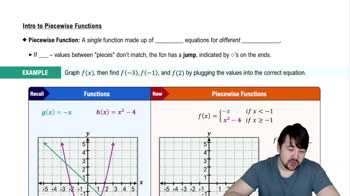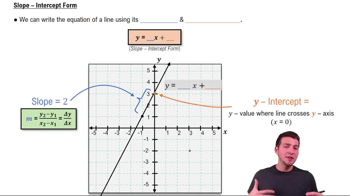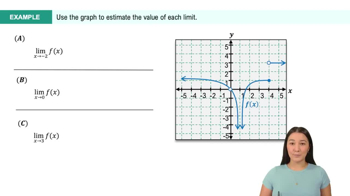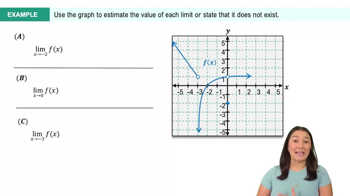Table of contents
- 0. Functions7h 52m
- Introduction to Functions16m
- Piecewise Functions10m
- Properties of Functions9m
- Common Functions1h 8m
- Transformations5m
- Combining Functions27m
- Exponent rules32m
- Exponential Functions28m
- Logarithmic Functions24m
- Properties of Logarithms34m
- Exponential & Logarithmic Equations35m
- Introduction to Trigonometric Functions38m
- Graphs of Trigonometric Functions44m
- Trigonometric Identities47m
- Inverse Trigonometric Functions48m
- 1. Limits and Continuity2h 2m
- 2. Intro to Derivatives1h 33m
- 3. Techniques of Differentiation3h 18m
- 4. Applications of Derivatives2h 38m
- 5. Graphical Applications of Derivatives6h 2m
- 6. Derivatives of Inverse, Exponential, & Logarithmic Functions2h 37m
- 7. Antiderivatives & Indefinite Integrals1h 26m
1. Limits and Continuity
Introduction to Limits
Problem 2.7.25
Textbook Question
Use the precise definition of a limit to prove the following limits. Specify a relationship between ε and δ that guarantees the limit exists.
lim x→7 f(x)=9, where f(x)={3x−12 if x≤7
x+2 if x>7
 Verified step by step guidance
Verified step by step guidance1
<Step 1: Understand the problem.> We need to prove that \( \lim_{{x \to 7}} f(x) = 9 \) using the precise definition of a limit. The function \( f(x) \) is defined piecewise: \( f(x) = 3x - 12 \) for \( x \leq 7 \) and \( f(x) = x + 2 \) for \( x > 7 \).
<Step 2: Recall the definition of a limit.> The precise definition of a limit states that for every \( \varepsilon > 0 \), there exists a \( \delta > 0 \) such that if \( 0 < |x - 7| < \delta \), then \( |f(x) - 9| < \varepsilon \).
<Step 3: Analyze the piecewise function.> For \( x \leq 7 \), \( f(x) = 3x - 12 \). We need \( |(3x - 12) - 9| < \varepsilon \). Simplifying, this becomes \( |3x - 21| < \varepsilon \), or \( |3(x - 7)| < \varepsilon \).
<Step 4: Solve for \( \delta \) for \( x \leq 7 \).> From \( |3(x - 7)| < \varepsilon \), we have \( |x - 7| < \frac{\varepsilon}{3} \). Thus, for \( x \leq 7 \), we can choose \( \delta = \frac{\varepsilon}{3} \).
<Step 5: Analyze the function for \( x > 7 \).> For \( x > 7 \), \( f(x) = x + 2 \). We need \( |(x + 2) - 9| < \varepsilon \). Simplifying, this becomes \( |x - 7| < \varepsilon \). Thus, for \( x > 7 \), we can choose \( \delta = \varepsilon \).
Recommended similar problem, with video answer:
 Verified Solution
Verified SolutionThis video solution was recommended by our tutors as helpful for the problem above
Video duration:
3mPlay a video:
Was this helpful?
Key Concepts
Here are the essential concepts you must grasp in order to answer the question correctly.
Definition of a Limit
The precise definition of a limit states that for a function f(x) to approach a limit L as x approaches a value c, for every ε > 0, there must exist a δ > 0 such that if 0 < |x - c| < δ, then |f(x) - L| < ε. This formal definition is crucial for proving limits rigorously.
Recommended video:

One-Sided Limits
Piecewise Functions
A piecewise function is defined by different expressions based on the input value. In this case, f(x) has two definitions: 3x - 12 for x ≤ 7 and x + 2 for x > 7. Understanding how to evaluate limits at points where the function changes its definition is essential for solving the limit problem.
Recommended video:

Piecewise Functions
Epsilon-Delta Proof
An epsilon-delta proof involves demonstrating that for any chosen ε, a corresponding δ can be found that satisfies the limit definition. This method is used to show that as x approaches a certain value, the function's output can be made arbitrarily close to the limit, thus confirming the limit's existence.
Recommended video:
Guided course

Slope-Intercept Form

 6:47m
6:47mWatch next
Master Finding Limits Numerically and Graphically with a bite sized video explanation from Callie
Start learning




